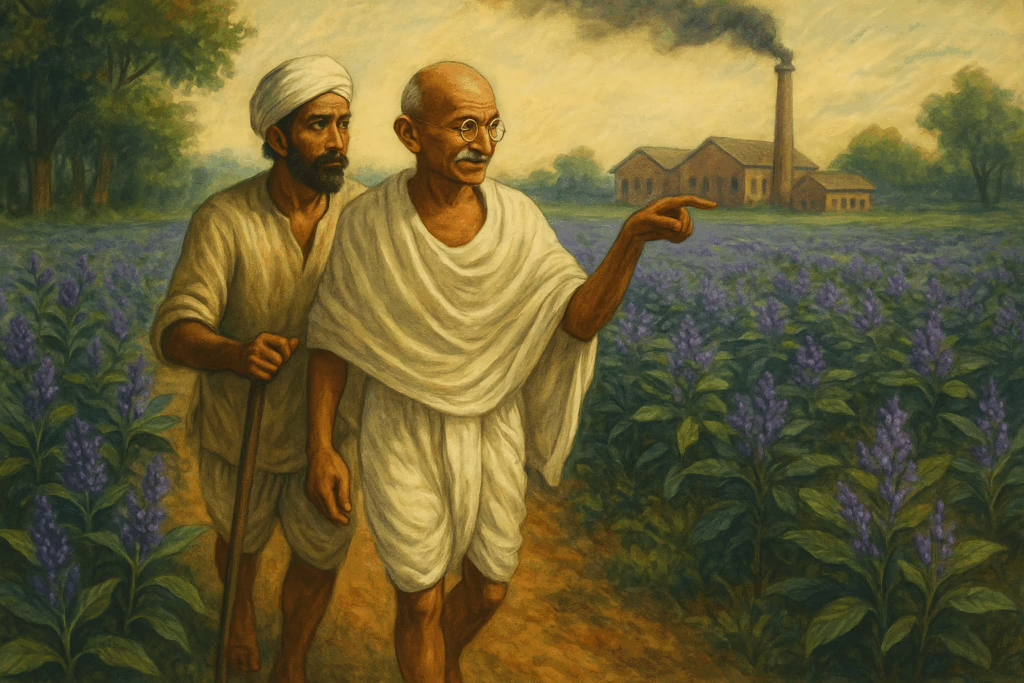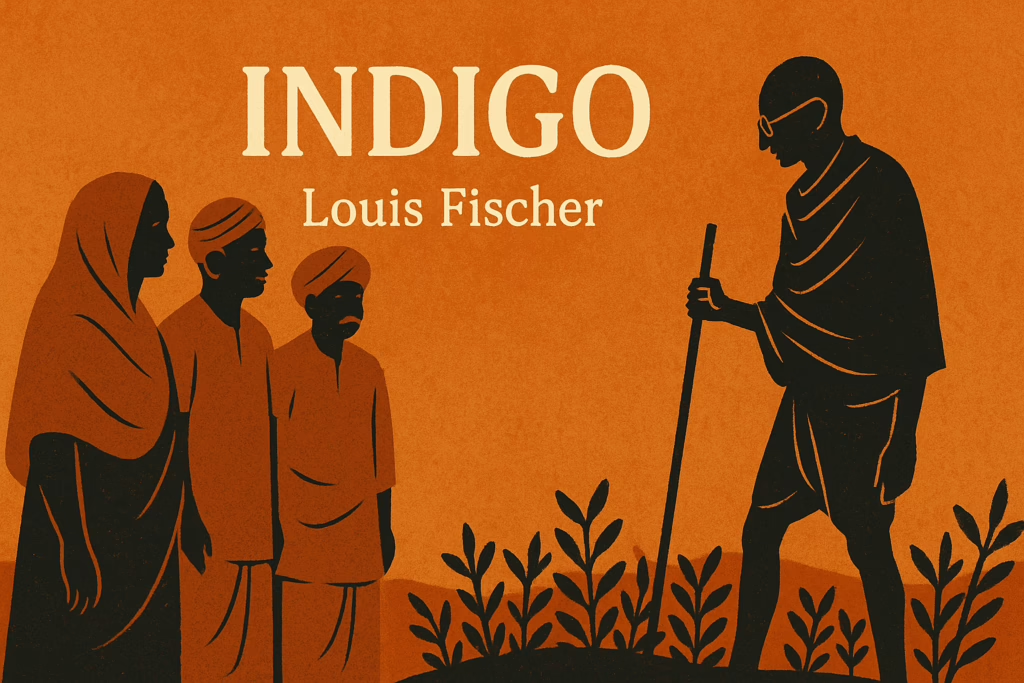Summary of Indigo
Indigo by Louis Fischer describes Mahatma Gandhi’s first major struggle for civil rights in India—the Champaran movement of 1917. Gandhi was approached by Rajkumar Shukla, a poor and persistent sharecropper from Champaran, who requested Gandhi to help the indigo-growing peasants oppressed by British landlords. Although Gandhi was busy, Shukla followed him everywhere until Gandhi finally agreed to visit Champaran.
Upon reaching Bihar, Gandhi learned that thousands of peasants were forced under an old system to grow 15% of their land with indigo, which had to be given as rent to British planters. When synthetic indigo was discovered in Germany, the landlords wanted to free the peasants from this system—but only after extorting compensation from them. Gandhi decided to investigate and collect accurate information directly from the peasants.
The British tried to stop Gandhi by ordering him to leave Champaran, but Gandhi refused, choosing to follow the voice of conscience. This marked his first act of civil disobedience in India. His courage inspired the local lawyers and peasants to support him. Soon, an official inquiry was set up, and Gandhi presented the truth fearlessly.
The British landlords finally agreed to refund money to the peasants, and Gandhi accepted a 25% refund—not for the amount, but because it symbolised the landlords’ surrender of pride and power. The outcome restored confidence among the peasants, ended the exploitative sharecropping system, and ultimately led to improved living conditions.
The Champaran episode was a turning point in Gandhi’s life. It showed that India’s freedom movement could succeed through non-violence, truth, courage, and mass participation. Gandhi also encouraged social reforms—schools, healthcare, and hygiene—believing that true freedom meant improving people’s lives, not merely political victory.
About the Author — Louis Fischer
Louis Fischer (1896–1970) was an American journalist, political writer, and biographer known for his insightful writings on world leaders and global political movements. Born in Philadelphia, Fischer worked as a teacher before turning to journalism and eventually becoming a respected foreign correspondent. He lived for many years in Europe and India, reporting on international affairs with clarity and depth.
Fischer developed a close association with Mahatma Gandhi and wrote several works on him, including the well-known biography The Life of Mahatma Gandhi. His writing is marked by factual accuracy, human insight, and a simple, engaging style. In Indigo, Fischer presents Gandhi not only as a political leader but as a humanitarian whose courage and compassion transformed the lives of poor peasants. His portrayal provides readers with a vivid understanding of Gandhi’s principles of truth, non-violence, and justice.

Textual Questions and Answers
COMPREHENSION CHECK
1. Strike out what is not true:
a. Rajkumar Shukla was
(i) a sharecropper.(ii) a politician.(iii) delegate.(iv) a landlord.
b. Rajkumar Shukla was
(i) poor.(ii) physically strong.
(iii) illiterate.
2. Why is Rajkumar Shukla described as being ‘resolute’?
Rajkumar Shukla is described as resolute because he followed Gandhi everywhere for weeks, waited patiently at every place Gandhi visited, and did not leave his side until Gandhi agreed to visit Champaran.
3. Why do you think the servants thought Gandhi to be another peasant?
The servants thought Gandhi was another peasant because he wore simple clothes, travelled with Shukla, and looked as poor and humble as the sharecroppers who often visited Rajendra Prasad.
COMPREHENSION CHECK
1. List the places Gandhi visited between his first meeting with Shukla and his arrival at Champaran.
Gandhi visited Lucknow, Cawnpore, Ahmedabad, Calcutta, Patna, Muzzafarpur, and Motihari before reaching Champaran.
2. What did the peasants pay the British landlords as rent? What did the British want instead and why? What would be the impact of synthetic indigo on natural indigo?
- The peasants paid 15% of their land produce (three-twentieths) as indigo rent.
- After Germany developed synthetic indigo, the landlords wanted compensation money from peasants to release them from the old sharecropping system.
- Synthetic indigo would drastically reduce the price of natural indigo and make it unprofitable, forcing planters out of business.
COMPREHENSION CHECK
1. Instances of Gandhi’s method of working linked to satyagraha and non-violence:
- He collected first-hand information directly from peasants.
- He refused to leave Champaran despite official orders — civil disobedience.
- He cooperated politely with officials and controlled the crowd — non-violence.
- He influenced lawyers with moral reasoning.
- He insisted on self-reliance, rejecting help from Andrews — moral strength.
These reflect his satyagraha principles: truth, non-violence, fearlessness, and self-suffering.
COMPREHENSION CHECK
1. Why did Gandhi agree to a settlement of 25% refund to the farmers?
Gandhi agreed to the 25% refund because he believed the amount was less important than forcing the landlords to acknowledge their injustice and surrender some of their prestige, which restored confidence and courage in the peasants.
2. How did the Champaran episode change the plight of the peasants?
The peasants gained courage, recognised their rights, and were no longer afraid of English planters. Eventually, the planters abandoned their estates, and the exploitative indigo sharecropping system was abolished, improving peasants’ lives permanently.

UNDERSTANDING THE TEXT
1. Why did Gandhi consider the Champaran episode to be a turning point in his life?
Gandhi considered it a turning point because it was his first successful civil disobedience movement in India. It proved that non-violent mass protest could challenge British authority and uplift the poor, shaping his path as a national leader.
2. How was Gandhi able to influence the lawyers?
Gandhi influenced them through his courage and moral conviction. When he said he would go to jail for the peasants, the lawyers realised that deserting the cause would be shameful. Inspired by his dedication, they agreed to join him even if it meant imprisonment.
3. What was the attitude of the average Indian in smaller localities towards advocates of ‘home rule’?
They were afraid to show sympathy publicly toward home-rule activists. Supporting freedom fighters could bring punishment from British authorities, so people remained cautious and fearful.
4. How do we know that ordinary people also contributed to the freedom movement?
Ordinary peasants gathered in thousands to support Gandhi, volunteered information, and courageously stood before British officials. Their mass participation in court demonstrations shows they actively contributed to the movement.
TALKING ABOUT THE TEXT
1. “Freedom from fear is more important than legal justice for the poor.” Do you think the poor in India are free from fear after Independence?
Despite legal rights, many poor people in India still fear exploitation, corruption, social injustice, and powerful authorities. True freedom from fear requires economic security, awareness of rights, and protection from abuse — all of which are still challenges today.
2. The qualities of a good leader.
A good leader must be truthful, courageous, compassionate, selfless, disciplined, and able to inspire trust. Gandhi demonstrated these qualities by standing with the poor, rejecting violence, and setting personal examples of moral strength.

WORKING WITH WORDS
Words related to legal procedures in the text:
- Deposition
- Summons
- Bail
- Case
- Verdict
- Magistrate
- Commission
- Official notice
- Prosecutor
- Trial
Other similar legal terms:
- Affidavit
- Petition
- Prosecution
- Counsel
- Jurisdiction
- Litigation
- Testimony
- Cross-examination
THINKING ABOUT LANGUAGE
1. Why does the author use quotations in his narration?
The author uses quotations to present Gandhi’s exact words, make the narrative lively, highlight his personality, and provide authenticity to the historical account.
2. Use or non-use of commas:
- In (a) and (c), the comma appears because the subordinate clause comes first.
- In (b), no comma is needed because the subordinate clause comes after the main clause.
THINGS TO DO
(Model outline for your project — you can choose any controversy)
Issue Example: Narmada Dam Project
Facts: Displacement of villagers, loss of livelihood, environmental concerns.
Arguments:
- For: Electricity generation, irrigation benefits.
- Against: Human displacement, ecological damage.
Settlement:
- Adequate compensation, rehabilitation, environmental safeguards, and smaller dams instead of mega-dams.


